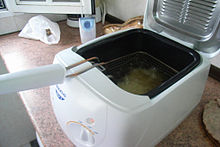Cookbook:Roast Potatoes
| Roast Potatoes | |
|---|---|
| Category | Potato recipes |
| Difficulty | |
Cookbook | Recipes | Ingredients | Equipment | Techniques | Cookbook Disambiguation Pages | Recipes
Roast potatoes (also known colloquially as 'roasties') are usually used as the prime starch accompaniment to a roast dinner, which is usually made up of a roast meat and several different vegetables. Some people, however, prefer to make and eat them by themselves or with other pairings.
Ingredients
[edit | edit source]Procedure
[edit | edit source]Method I
[edit | edit source]- Preheat the oven to 220°C (425°F, gas mark 7).
- Peel the potatoes, and slice them into quarters or eighths depending on the size of the potato. Smaller pieces tend to make crispier roast potatoes, and larger pieces tend to make softer ones.
- Put the potatoes in a saucepan of water, and add a pinch of salt if you wish.
- Cover, bring the contents to the boil, and allow to simmer for 10 minutes to parboil the potatoes prior to roasting.
- Drain the potatoes, either removing with a slotted spoon or with a metal colander.
- Replace the lid and shake the potatoes vigorously for 20–30 seconds.
- Lightly coat potatoes with oil or fat, such as by hand tossing in a bowl, and place in tin. A deep tin is safer than a shallow tin, as shallow tins tip easily, spilling any loose oil.
- Sprinkle salt over the top of the potatoes.
- Place in oven, then roast for 20–50 minutes—tastes and ovens differ—or until the potatoes are golden brown.
- Remove them from the oven. Be careful if there is any excess oil in the pain—it is hot and can cause burns. The safest thing is to let potatoes cool to 30–40°C in oven before removing, or alternatively to carefully pull the tray partly out, and remove potatoes individually with tongs or a metal spoon.
- Serve hot; they can be kept warm in the oven, but should not be piled up much, if at all.
Method II – Frying
[edit | edit source]Between the parboiling and roasting, you can deep fry the potatoes in hot oil, which yields crispier potatoes, much like crisps/French fries. You should be familiar with deep frying safety before attempting this, and in case of any cooking oil accidents, immediately call emergency services.

Deep fryer
[edit | edit source]- Parboil the potatoes as above, then drain and dry (potatoes must be dried to avoid splatter from boiling water in hot oil).
- Briefly deep fry the potatoes.
- Transfer potatoes to oven and roast as above
Tray-frying
[edit | edit source]Alternatively, one can heat oil or fat in a tray in the oven, then add the boiled potatoes to the hot oil, but this is more dangerous.
- Preheat oil in deep tray in oven.
- Parboil the potatoes as above, then drain and dry (potatoes must be dried to avoid splatter from boiling water in hot oil).
- Leaving the tray in the oven and wearing an oven mitt, and very carefully pull the rack out enough to access the hot oil. It is safest to stand behind the oven door, and only pull out the rack slightly to prevent spilling of hot oil onto you.
- Transfer the potatoes individually into the tray with tongs, rotating to coat them in oil. Alternatively baste in oil with a metal spoon—they will sizzle. Alternatively, one may tip the potatoes from the saucepan into the tin and then coat potatoes in oil or fat, but this risks splashing and spills.
- Transfer potatoes to oven and roast as above.
Notes, tips, and variations
[edit | edit source]- Times and quantities are rough and can vary to suit individual tastes.
- The roughing up of the surface of the potatoes is key to a crispy surface—this is the purpose of the shaking, and it can alternatively or additionally be accomplished by scraping the surface of the potatoes with a fork. Compare with forking the top of the mash in shepherd's pie.
- If initially deep-frying, the fat or oil must be hot before adding the potatoes—they should sizzle when added—or else they will be greasy rather than fluffy and crisp.
- Some advocate flipping the potatoes half-way through roasting, while others assert that this is unnecessary. You may also wish to carefully baste with oil partway through the roast, to ensure an even coating; again, some find this necessary, while others do not.
- Potatoes can also be cooked in the same oven and same roasting tin as the meat or other vegetables if being included as part of a roast dinner; they should go in half an hour before the meal is to be served.
- Note that the roast and other dishes may require or benefit from different cooking than the potatoes—both different temperature and different time—and hence it may be easier to cook them separately, or at least to take these differences into account. Using the fat from the roast requires a significant amount of fat on the roast and room in the tray—you will often find that cooking separately or with additional fat or oil is better.
- Garlic and herbs may be added to the fat. Garlic should be crushed or minced. Commonly used herbs, which may be used singly or together, include basil, marjoram, thyme, oregano, parsley, or dill weed.
- Animal fat (fat from accompanying roast meat, goose fat, duck fat, or lard) is generally averred to give superior potatoes, but is alas not suitable for vegetarians.
Warnings
[edit | edit source]- The oil in the roasting tin will be well over 100°C. Be extremely careful when handling the tin, and safest is to avoid any handling of the hot oil.